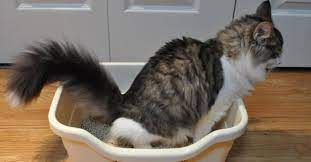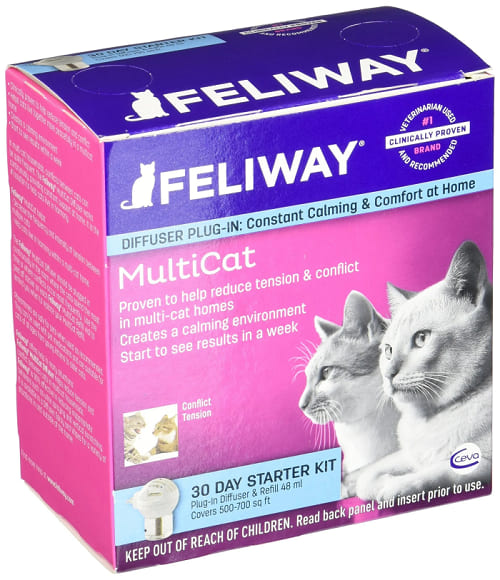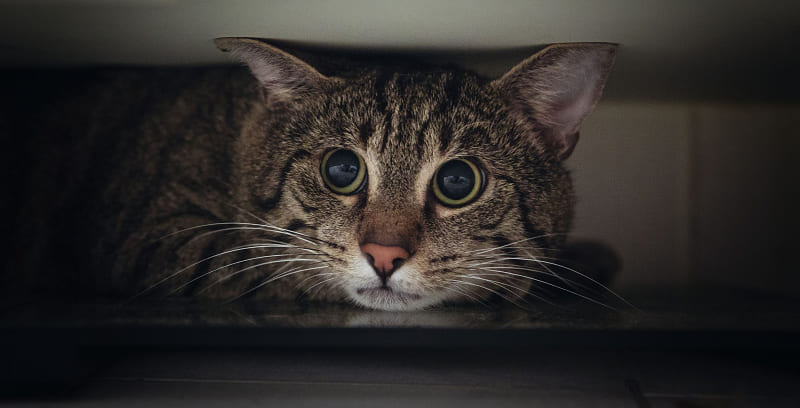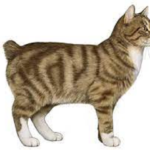Cystitis (non-bacterial bladder inflammation) in Cats
This condition is also known as Feline Interstitial Cystitis, Feline Idiopathic Cystitis, FIC.

Cystitis is any kind of inflammation in the wall of the urinary bladder that causes clinical signs in pets. Cystitis may result from a bacterial infection or bladder stones.
However, young and middle-aged cats in particular get sterile cystitis, which means it is not caused by bacteria or stones.
While bacterial cystitis, an infection, is treated with antibiotics, and cystitis caused by bladder stones is taken care of by removing the stones (surgically or medical dissolution) and a change of diet, sterile cystitis can be tough to deal with because there is nothing obvious to treat besides increased water consumption and decreased stress.
Most commonly the evaluation by your veterinarian will include a history, physical examination, a complete urinalysis, and X-rays or possibly an abdominal ultrasound or even a limited ultrasound scan of the bladder.
A complete blood count (CBC) and chemistry panel may also be done.
Dogs rarely get sterile cystitis but in some cases if water is restricted it can occur. In contrast, it’s quite common among young to middle-aged cats.
A similar condition occurs in people called interstitial cystitis.
Idiopathic sterile cystitis is thought of as the most common urological disease of young cats. It is less likely to start after the age of 10-12 years.
When the urinary tract just isn’t quite right, you can see signs in your cat (an in some cases, you dog), but you need to look carefully. Clinical signs of lower urinary tract disease can include:
- Bloody urine
- Straining
- Painful urination
- Inappropriate urination (outside the box)
- Urinary frequency
- Frequent genital licking
- Inability to urinate despite frequent attempts (see more below; blocked cats are a veterinary emergency)
In sterile cystitis, these signs may be episodic and the most common one is usually blood in the urine, either visible to your eye or only under a microscope.
While you will know soon if your cat is going outside the box or going frequently, you may not notice the straining and signs of pain while trying to urinate unless you are paying attention to your cat’s litter box habits.
It can be frustrating when there is no specific test for the actual, most common cause of a problem.
Testing, such as a culture for bacteria or radiographs to look for stones, may be done to look for the less common causes of bladder disease in the younger age groups.
If We Can’t Find Anything Wrong, why is my Pet Peeing Blood?
The bladder’s health affects the rest of the body, and the body’s overall health affects the bladder. An affected animal may well have another disease or syndrome at the same time.
Importantly, it turns out that chronic early stress for a cat can change gene expression that can lead to disease.
Stress in early life – orphaned, needing to be bottle fed, exposure to environmental instability, trauma, disease – can all lead cats to be more susceptible to illness throughout their lives.
In other words, a cat’s owner hasn’t likely done anything wrong to cause their cat to have this issue.
The seeds may have been sown in a kitten’s early life or by the mother’s experiences before the kitten was even born. That said, it can be helpful to reduce any known environmental the stress.
Cats with sterile cystitis also show abnormal hormonal response to subsequent stressors. This stress response can promote inflammation and pain in the bladder for some cats.
In these cats, the inflammation and pain will progress to a chronic disorder that is resistant to treatment, such as in the case of sterile cystitis.
Often, clinical signs associated with environmental events come and go.
Other problems such as obesity, shyness or aggressiveness, intermittent vomiting, diarrhea, poor appetite, asthma, over-grooming, or even a mild heart murmur may all be issues created or compounded by stress.
Use Multiple Therapies to Prevent Flare-ups
Specific veterinary diets can make a big difference in male cats who end up with a urinary blockage at the cat’s urethra.
While bladder stones can cause a blockage, in cases such as Pandora, the blockage is usually caused by a paste-like mix of mucus and protein called matrix.
As mentioned, a blockage is a veterinary emergency.

Even if the cat is experiencing a bout of Pandora, on a certain diet they might be less likely to have a related life-threatening obstruction.
Veterinary diets designed for cats with sterile cystitis might promote more dilute urine and contain fatty acids to help reduce inflammation.
A wet food (canned or in pouches) can also have the same benefit of making the urine more dilute.
Unfortunately, there have not been any clinical trials to prove that certain medications are effective.
Some are tried empirically, meaning that the veterinarian’s choice of medication and dosage is formed based on their own experience using those drugs.
Sterile cystitis can be tough to deal with and it may take some trial and error to see what works for an individual cat.
We try to prevent the inflammation and pain caused by feline stress by lessening the stress.
A program referred to as Multimodal Environmental Modification – MEMO for short – has proven it lessens stress and the resulting complications of inflammation, urinary bladder pain, and clinical signs. The aim is to reduce the types of stress that cause sterile cystitis.
Because it involves shaping behavior, it is more than sneaking a pill or two into your cat.
A cat owner must be dedicated to do everything that can help a cat suffering from Pandora syndrome.
You and your veterinarian should work together to find an enriching lifestyle that does not cause your cat stress, which can be a rewarding process.

The basic principles are:
- Safe spaces, including vertical space
- Food they like, increased water intake
- Litter box satisfaction
- Play
- Conflict resolution
Studies show that the MEMO approach often reduces or removes urinary tract symptoms and associated problems completely.
Medications are used to ease pain and signs, but the goal to keep in mind is a life free from recurrences and no need for stress medication.
Does your cat have a safe space to get away from people and other pets?
Do they like their food, the way their water is provided?
Do they like their litter boxes? Do they play enough?
Are they living with constant unresolved conflict, perhaps with another cat or pet, or a person or machine they do not care for?
The majority of cats will cycle – often with stress – in and out of having signs of Pandora syndrome. Even when MEMO is done well, episodes can recur; it’s not likely possible to eliminate the signs entirely, and new stressors will appear eventually.
The goal with MEMO is to have episodes become less common.
Not all disease stems from stress. However, using MEMO to your advantage is likely all it takes to make your stressed cat become happy with less chronic stress-related urinary issues.
Your veterinarian may also consider trying medications for straining, pain and/or anxiety, particularly during an active bout of the disease to make your cat more comfortable until they cycle out of the active phase of the disease.


